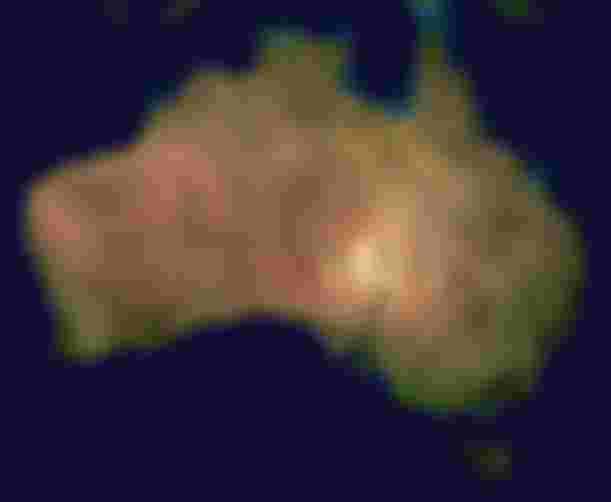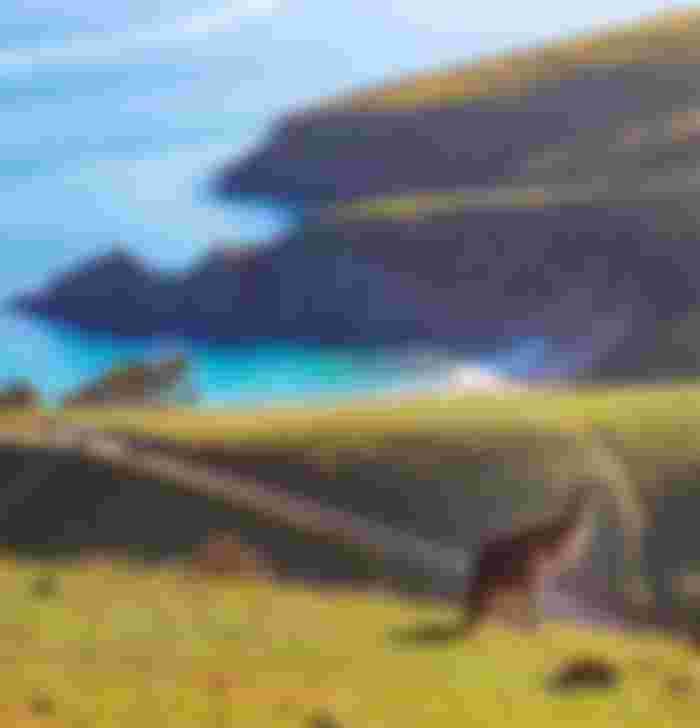The "Land Down Under"
If you look at a globe, you can see why the continent of Australia is often called the "land down under." Far away from the land masses of other continents, all of Australia lies in the Southern Hemisphere. In fact the name Australia comes from the Latin word meaning "southern land."

Australia is the smallest continent. It is about the same size as the United States without Alaska Hawaii. It is the only continent that has only one nation--also know as Australia.
Most of Australia is flat. The western two thirds of the land is a plateau. Deserts cover much of this plateau. The people of Australia call this dry region the outback.
The outback lies "out back." You might say it got its name from the fact that most Australians tend to live "up front" in the more fertile lands of the east.
The deserts of Australia's outback have names, of course. The desert is called the Great Sandy Desert, and in the south it is called Great Victoria Desert. Between these two deserta lies the Gibson Desert. Together, these deserts make up the second largest desert in the world. Only Sahara is larger. The Gibson Desert has a rocky surface, but the other deserts are areas of high, drifting dunes.
Most Australians live on the eastern coastal plains. Ranges of low mountains border the coastal plains from the outback. Called the Great Dividing Range, these highlands wind their way all the way down the eastern edge of Australia. The highest mountains are the Australian Alps, at the southern end of the Great Dividing Range. Australia's highest peak is Mount Kosciusko. Between the western plateau and the mountains of the east lie the central lowlands. This area covers about one third of the continent, from the Gulf of Carpenteria in the north to the Indian Ocean in the south. This vast region is made up largely of low-lying plains. Most of the land is between 500 and 1,000 feet (150-300 m) above sea level.
The Lake Eyre Basin, in the south-central part of the central lowlands, is the driest place in Australia. The lake itself is usually only a great flat area of salt and mud, and the rivers that flow into it often do not run for many years at a time.

Australia's Animal Life
One of the most interesting things about Australia's geography is its animal life. It has many animals that are unlike those found in other parts of the world. For example, the best known of Australia's animals is the kangaroo. When the first European explorers arrived in the Australia in the eighteenth century.
With its body like greyhound and its head like a rabbit, it has no resemblance to any European animal ever seen.
Perhaps the stranges animal of all is the platypus. Like a duck, it has a bill and webbed feet. Like a snake, it has fangs and can squirt a poisonous venom.
Coral polyps, though not found only in Australia, are another important form of animal life. There are billions of coral animals in the warm, clear water of the Pacific. The skeletons they leave behind build up coral reefs, or long stretches of coral rock. The largest coral reef in the world is the Great Barrier Reef, which stretches for more than 1,250 miles (2,010 km) along Australia's north eastern coast.
In 1979 the government of Australia set aside part of the Great Barrier Reef as a marine park. Every year thousands of people from all over the world visit this natural wonder.
Three Island Groups
Coral reefs are common in the southern part of the Pacific Ocean. Oceania is made up of thousands od large and small islands. Divided into three groups -- Polynesia, Micronesia, and Melanesia- these groups of islands stretch far across the Pacific Ocean.
The country of New Zealand is made up of the two largest islands of Oceania. The center of North Island is a volcanic plateau. This is a region of many hot springs and geysers, much like Yellowstone Park in the United States. South Island is more mountainous than North Island. Glaciers are found on the mountains of South Island. Mount Cook, New Zealand's highest peak, rises dramatically over the island.
Like the islands of New Zealand, most Pacific islands are formed by the tops of mountains rising from the ocean floor. Many of these mountains are active volcanoes. Their flaming eruptions have earned the South Pacific the nickname "Ring of Fire."
Many parts of Oceania lie along the unstable plates of the earth's surface. Thus many of the islands are being slowly raised or lowered. If an island with a coral reef is lowered, the island is separated from the reef by water. The reef continues to grow upward, the water lying between an island shore and a reef is called a lagoon.
An island that is surrounded by a barrier reef may continue to sink. Eventually, only a ring shaped coral coral island remains above sea. Such an island is called an atoll. Most atolls are shaped like a circle and surround a lagoon.
"The Last Places on Earth"
Australia and the islands of Oceania have been called "the last places on earth." As you know, they are located in the Southern Hemisphere, far away from Asia, Africa, and Europe.


I love this